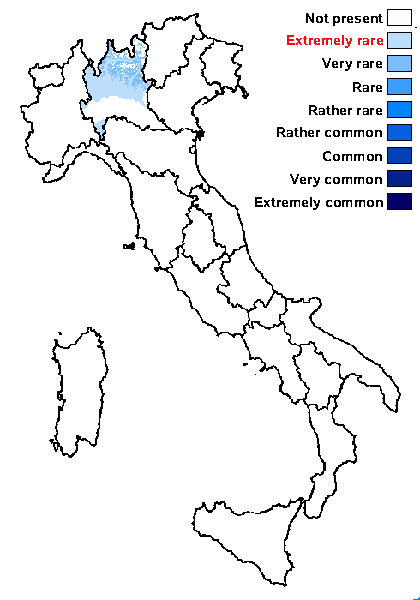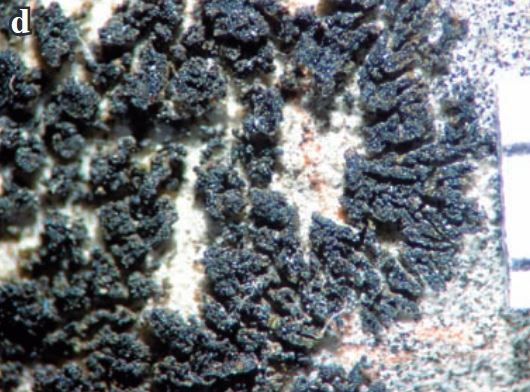Placynthium posterulum (Nyl.) Henssen
in Crzeika & Czeika, Herzogia 20: 44, 2007.. Basionym: Pterygium posterulum Nyl. - Flora, Regensburg, 58: 7, 1875.
Synonyms:
Distribution: N - Lomb (Anzi Lich. Lomb. 442: Czeika & Czeika 2007).
Description: Thallus subcrustose-placodioid, olive-brown to brown-black, sometimes pruinose especially at lobe-tips, without a distinct pro- or hypothallus (in section colourless to pale brown in lower part, never bluish), forming regular to irregular, often confluent 3-9 mm wide rosettes. Central parts of thallus consisting of cylindrical to granulose, densely packed, erect outgrowths which often fall off, leaving semi-circular rings of marginal lobes; marginal lobes up to 1 mm long and 0.09-0.15 mm wide, terete, usually separate, rather loosely attached by colourless to brownish rhizohyphae. Upper surface of lobes with densely packed, parallel hyphae, the photobiont cells mostly concentrated near the surface; central parts of lobes with a more or less well-developed hyphal strand; lower surface with colourless rhizohyphae. Apothecia extremely rare, lecanorine, sessile, 0.2-0.3 mm across, with a flat, black disc and a brown, corticate thalline margin. Epithecium greenish blue; hymenium colourless; hypothecium pale brown. Asci 8-spored, apically thickened, with an amyloid cap. Ascospores 1-septate, hyaline, ellipsoid, 10-12 x 4.5-5.5 µm. Photobiont cyanobacterial, Scytonema-like. Spot tests: all negative. Chemistry: without lichen substances.Note: a poorly known species found on steeply inclined surfaces of calcareous rocks in sunny situations with periodical water seepage after rain, with optimum in the montane belt.
Growth form: Crustose placodiomorph
Substrata: rocks
Photobiont: cyanobacteria, filamentous (e.g. Nostoc, Scytonema)
Reproductive strategy: mainly asexual, by isidia, or isidia-like structures (e.g. schizidia)
On otherwise dry surfaces with short periods of water seepage after rain
Poorly known taxon in need of further study
Commonnes-rarity: (info)
Alpine belt: absent
Subalpine belt: very rare
Oromediterranean belt: very rare
Montane belt: very rare
Submediterranean belt: extremely rare
Padanian area: absent
Humid submediterranean belt: absent
Humid mediterranean belt: absent
Dry mediterranean belt: absent

Predictive model
Growth form: Crustose placodiomorph
Substrata: rocks
Photobiont: cyanobacteria, filamentous (e.g. Nostoc, Scytonema)
Reproductive strategy: mainly asexual, by isidia, or isidia-like structures (e.g. schizidia)
On otherwise dry surfaces with short periods of water seepage after rain
Poorly known taxon in need of further study
Commonnes-rarity: (info)
Alpine belt: absent
Subalpine belt: very rare
Oromediterranean belt: very rare
Montane belt: very rare
Submediterranean belt: extremely rare
Padanian area: absent
Humid submediterranean belt: absent
Humid mediterranean belt: absent
Dry mediterranean belt: absent

Predictive model
 INDEX FUNGORUM
INDEX FUNGORUM
 GBIF
GBIF


